 aweed fishery production increasing, and demand for MSC certification of seaweed harvesting increasing, the MSC has recognised the importance of having a standard that rewards those that are harvesting seaweed sustainably and also provides a benchmark for improvement.
aweed fishery production increasing, and demand for MSC certification of seaweed harvesting increasing, the MSC has recognised the importance of having a standard that rewards those that are harvesting seaweed sustainably and also provides a benchmark for improvement.As a marine resource, wild-harvest and enhanced seaweed fisheries fall within the scope of the standard, which excludes only fisheries that target reptiles, amphibians, birds and mammals, and fisheries employing explosives and poison.
During the MSC’s Technical Advisory Board (TAB) meeting in December 2013, the decision was made to proceed with developing a modification of its fishery standard for use with wild and enhanced seaweed harvesting. The draft proposal is expected to be available for consultation in late 2014. When complete, it will be the first global standard for sustainable seaweed.
A sustainable seaweed fishery needs the same level of management and monitoring as an equivalent animal fishery, with both requiring stock assessments and harvest control rules. However, sustainable best practice for seaweed fisheries is not yet as well developed as it is for other types of fishery; the MSC will therefore be conducting further research to identify indicators of sustainability for both stock status and ecosystem impact.
Seaweed can be used as a food source, both for humans and as a substantial feedstock for biofuel production, it is found in cosmetics and pharmaceuticals, and also as an ingredient in fertilizers.





